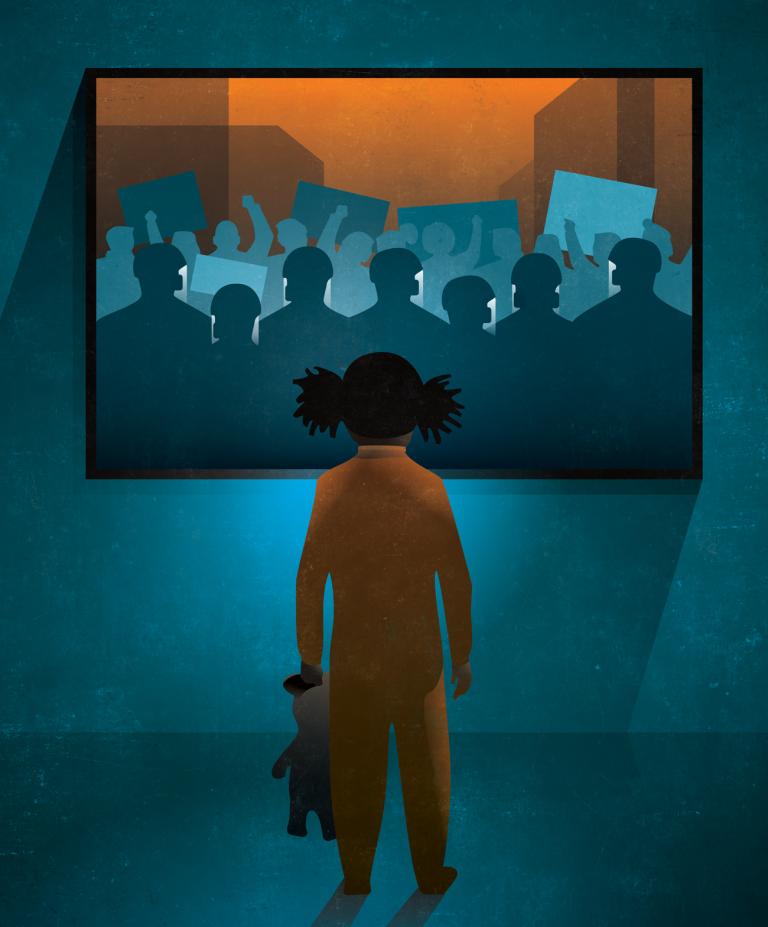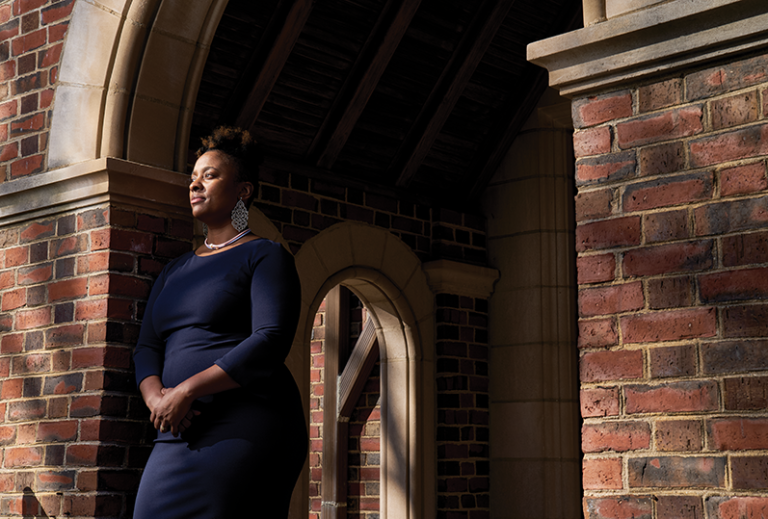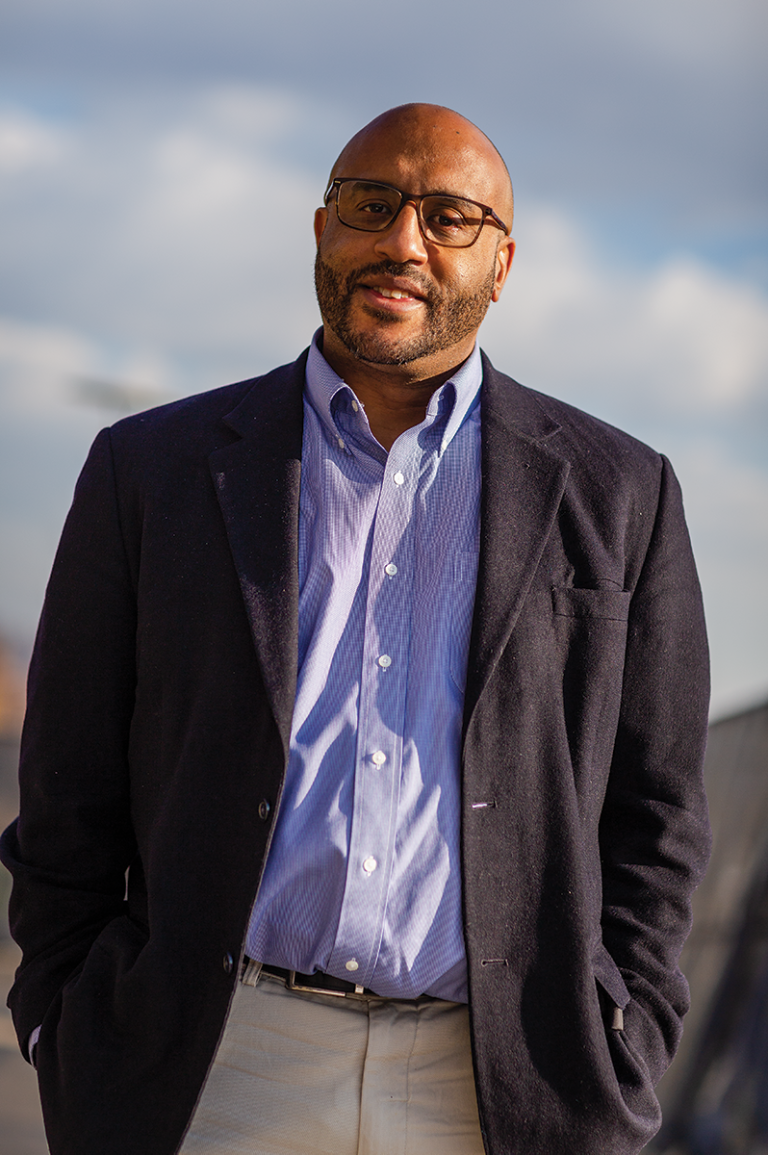Through the Eyes of a Child
The barrage of strife, unrest, and outrage over the deaths of Black people in this country falls hard on the young
- 14 minute read
- Feature

Maybe it hasn’t actually been the worst year ever, as internet memes are calling it, but for most of us, 2020 really has been “extra.” Against the backdrop of a pandemic that has created economic havoc and kept people from loved ones and purpose-defining work, the country has endured its greatest social unrest in decades, largely driven by a relentless daily barrage of horrifying racial incidents delivered up close and in real time. And, in the ultimate betrayal, these incidents—from the killings of Black men at the hands of police to countless “Karen” encounters on public and private property—have often been encouraged by the very government meant to protect us.
If you, as an adult, have been feeling anxious and distressed, imagine what all this is doing to children.
“This year has been exceptionally challenging for Black youth,” says James Huguley, interim director of the University of Pittsburgh’s Center on Race and Social Problems. “Because of the racial disparities in our broken system, they’re more likely to know someone affected by COVID-19. The social isolation makes everything worse, and most kids who receive mental health support get it at school, where most of them have not been since February. And at the same time all these racial atrocities in policing are happening.”
Racial trauma operates on many levels, Huguley notes, from microaggressions to personal experiences with discrimination to longstanding, intentionally instituted structural disadvantages that over hundreds of years have led to ingrained economic hardship, housing insecurity, carceral system injustice, unsettling family dynamics, and other adverse consequences. “We do surveys with Black youth here in Pittsburgh, and kids ages 10 to 15 are reporting that people have been racist toward them,” he says. “By tenth grade about fifty percent of them have encountered racial discrimination.”
“The biology makes it clear: The body doesn’t forget. Early experiences both positive and negative literally shape the architecture of the developing brain.”
Black parents and educators point out that while white people are becoming more aware of discrimination, “where you stand depends on where you sit,” according to Altha Stewart, past president of the American Psychiatric Association and a senior associate dean for community health engagement in the College of Medicine at the University of Tennessee Health Science Center. “If you sit in the midst of a storm of the kinds of events that don’t usually make the news, that happen day in and day out in your community, it really is nothing new. The newness comes from the rapidity with which these images are coming at our kids.”
And, Huguley points out, although children may not be experiencing firsthand the things they’re seeing online or on television, “they’re identifying with the person who is experiencing it, who looks like them, so the trauma is vicarious.”
According to a 2018 paper in Social Science & Medicine, children are especially vulnerable to indirectly experienced racism because “children’s lives are inevitably linked to the experiences of other individuals, and they are in critical phases of development.” The researchers’ review of the literature on vicarious racism and child health found thirty-eight statistically significant childhood outcomes—including “general illness,” weight issues, depression, anxiety, socioemotional difficulties, delayed cognitive development, and externalized behavior problems—that can be associated with a child’s indirect exposure to the prejudice and discrimination that friends, family, and strangers may experience and to experiences that “threaten a child’s sense of the world as just, fair, and safe.”
The effects of childhood trauma, whatever its cause, can be lifelong. A 2019 paper published in the U.S. Centers for Disease Control and Prevention’s Morbidity and Mortality Weekly Report found that adverse childhood experiences, or ACEs, can “derail optimal health and development by altering gene expression, brain connectivity and function, immune system function, and organ function”; compromise “development of healthy coping strategies, which can affect health behaviors, physical and mental health, life opportunities, and premature death”; and have been linked with “increased risk for alcohol and substance use disorders, suicide, mental health conditions, heart disease, [and] other chronic illnesses,” including stroke, asthma, lung disease, cancer, kidney disease, diabetes, and depression. Other studies have associated adverse childhood experiences with obesity, physical inactivity, and high-risk sex behaviors, and, the MMWR authors write, these experiences have “been linked to reduced educational attainment, employment, and income.”
Bone deep
The roots of these effects can be seen far earlier than once thought possible. “We used to think that preschool kids experiencing a lot of adversity where they live or in their family didn’t understand what was going on or were too young to remember,” says Jack Shonkoff, an HMS professor of pediatrics at Boston Children’s Hospital and director of Harvard’s Center on the Developing Child, where he chairs the JPB Research Network on Toxic Stress, a research collaboration that is developing biological and behavioral measures of stress activation and resilience in children 4 months to 5 years old. These metrics include pro-inflammatory cytokine levels, epigenetic effects, cortisol levels over time, and measures of executive functioning skills and attention span.
“The general public belief is that early experiences don’t have lasting impacts until kids get older,” says Shonkoff, who is also the Julius B. Richmond FAMRI Professor of Child Health and Development at the Harvard T.H. Chan School of Public Health and Harvard Graduate School of Education and a research associate at Massachusetts General Hospital. “But now we know that even very young kids are affected. The biology makes it clear: The body doesn’t forget. Early experiences both positive and negative literally shape the architecture of the developing brain and other biological systems from the beginning.”

Alisha Moreland, a member of the HMS faculty of psychiatry and director of trauma-informed treatment, consultation, and outreach at McLean Hospital’s Center of Excellence in Depression and Anxiety Disorders, explains that the brain develops “from the bottom up and the inside out,” with deep brain structures like the amygdala, hippocampus, and hypothalamus that play a role in fear conditioning and the stress response; the brain stem and midbrain structures handling basic functions like regulating heart rate, breathing, sleeping, and eating; and the topmost parietal and frontal lobes managing sensation, perception, and executive function.
“Adolescents are impulsive and need external cues because their brains are still developing,” she says. “Part of the work of becoming an adult is learning how to modulate the fear response and move toward safety. But when the sense of threat never goes away, and you’re in a chronic state of seeking safety, that short circuits higher-order functions.”
Moreland mentions the seminal ACEs study undertaken by the CDC and Kaiser Permanente and published in the American Journal of Preventive Medicine in 1998. For that study, researchers assessed responses from nearly ten thousand individuals who Moreland notes “were overwhelmingly white, middle class, insured, and educated.” They found that more than one half of the respondents had had at least one adverse experience—a litany of harms that included psychological, physical, or sexual abuse, or living with a mentally ill or suicidal individual—that increased the risk for chronic health and behavioral problems. One quarter of the respondents had had two or more such experiences.
“That’s significant because the cohort had so many protective factors,” she says. “But even with working protective factors, individuals reported that something from their childhood had a significant impact.”
Both Moreland and Shonkoff mention three kinds of stress children can experience. Positive stress, they explain—the body’s response to normative experiences such as being made to share toys or going to day care for the first time—is healthy, teaching children coping mechanisms they can use throughout life. Tolerable stress is more serious, such as that following the death of a loved one, a natural disaster, or ongoing family discord. The most harmful level of stress, toxic stress, occurs when the stressor is severe and fairly continuous and there is no counterbalance, as experienced in some orphanages or other living situations marked by significant neglect or from the relentless additive effect of stressors such as deep poverty, systemic racism, and community violence. With toxic stress, Moreland points out that the need for safety—a basic need that forms the foundation of psychologist Abraham Maslow’s hierarchy of needs pyramid—isn’t fulfilled, making it more challenging for individuals to gain the sense of belonging, love, and self-esteem required to achieve the full potential and creativity at the pyramid’s top. Shonkoff adds that the persistent wear-and-tear effects of toxic stress on multiple organ systems can lead to higher rates of chronic physical impairments across a lifespan.
“Any environment that is devaluing or invalidating can contribute to stress,” Moreland says. “And racism is one form of that.” In children, toxic stress can look like clinginess, nervous habits, withdrawal, lack of focus, mood swings, reluctance to go to school, irritability, anger, acting out, and other troubling behaviors. “Black children and teens are more often misdiagnosed with disorders like ADHD because they are hypervigilant or aggressive,” Stewart says. “This could be the result of racial trauma.”
It also could be a perfect example of a vicious cycle created by bias in the labeling system. Oppositional defiant disorder is diagnosed more often in children of color, and at least one study found that among adolescents who become involved with the justice system, Black males are 40 percent more likely, and Black females 54 percent more likely, to be diagnosed with conduct disorder than white males and females, “even upon considerations of trauma, behavioral indicators, and criminal offending.” And even though high school suspension rates have dropped in the past decade, a 2016 study by the federal government’s Civil Rights Data Collection program found that Black students in high school are still twice as likely to be suspended as their white and Hispanic peers.
Clearly, something needs to change.
A guiding hand
The phrase “trauma-informed care” existed as far back as the mid-1980s, but the practice has come into widespread use only in the past decade. It’s an ACEs-based care approach that assumes everyone has had some trauma in their lives, and it starts not by asking “What is wrong with this person?” but instead “What has happened to this person?” It informs all aspects of school and social service programs or medical practices beginning on the first day or in the waiting room by “creating a physically and emotionally safe environment, establishing trust and boundaries, supporting autonomy and choice, creating collaborative relationships and participation opportunities, and employing a perspective that focuses on strengths and empowerment to promote resilience,” according to the Institute on Trauma and Trauma-Informed Care at the University at Buffalo Center for Social Research.
“Black children and teens are more often misdiagnosed with disorders like ADHD because they are hypervigilant or aggressive. This could be the result of racial trauma.”
Trauma-informed care aims to help people get “through,” not “over,” hurtful events in their past, but some have suggested it doesn’t go far enough for children and adults of color. Researchers from the National Crime Victims Research and Treatment Center at the Medical University of South Carolina, writing in the Journal of Child and Adolescent Trauma in 2020, suggested an update to the care protocol. The article, which proposes a culturally informed model for reducing the mental health effects of racism-related experiences, points out that “theoretical models of early childhood adversity have largely neglected the multifaceted influence of racism on mental health outcomes” and proposes extending the ACEs framework by making racism a distinct ACEs category.
“Gaining a more accurate and nuanced understanding of the prevalence, impact, and typologies of ACEs that disparately influence Black youth,” the paper states, “can shed light on targetable areas of intervention at the individual (e.g., adaptive coping strategies), contextual (e.g., community initiatives), and institutional (e.g., equitable health care) levels that can disrupt the noxious and lasting effects of adversity.”
Some schools and extracurricular programs have been leading this charge for decades. A scholar of the social foundations of education, Kristal Moore Clemons heads the Children’s Defense Fund’s Freedom Schools, a six-week summer literacy and cultural enrichment program that grew out of the Mississippi Freedom Summer Project of 1964 and, Clemons says, “empowers children to see beyond their current circumstances.” It encourages children to read books that reflect the Black experience and starts each day with songs, cheers, chants, and stomps focused on the concept of harambee, which is Swahili for “let’s pull together.”
Inside, out
For clinical physicians, trauma-informed and culturally-informed ACEs care means conveying understanding and trust, being aware of structural identity-based issues, and collaborating with patients in the healing process. It also means being careful not to retraumatize patients by requiring them to tell their stories repeatedly, regarding them as a number, labeling them, or being punitive or oppressive in language or treatment approaches.

“Frankly, some of the most troubling disparities are in the health sciences,” says Huguley. “On top of hundreds of years of medical exploitation, skewed research, gaps in infant mortality rates and maternal health, and clinical bias, there are countless sad stories about personal encounters in medical offices. Medicine really needs to look internally at this, because behind every hypertension statistic, there’s a life.”
Stewart agrees. “Anyone who is practicing today and not incorporating into their encounters with patients something that speaks to what’s going on in their world that can contribute to their symptoms may not be taking into full account the extent of our oath to provide the best possible care to the people who come to us.”
The first thing pediatricians and primary care providers must do is check their own biases and work to understand the origins of racial inequality, says Huguley. Mentoring students who are underrepresented in medicine also goes a long way toward increasing the pipeline of professionals all patients can relate to—and working to become part of the scaffolding of resilience for children can make a difference in individual lives.
“On top of hundreds of years of medical exploitation, skewed research, gaps in infant mortality rates and maternal health, and clinical bias, there are countless sad stories about personal encounters in medical offices. Medicine needs to look internally at this, because behind every hypertension statistic, there’s a life.”
We know we can keep tolerable stress from becoming toxic and behavior from going off the rails, Shonkoff notes, by providing protective adult relationships that make kids feel secure. “No child can survive significant adversity by pulling themselves up by the bootstraps,” he says. “But whether it’s a parent, a childcare or health care provider, a neighbor, or a teacher, just one person can confer the protective effect, bringing the stress system back to baseline by providing caring support.”
Adults may be able to parse racial discrimination for both themselves and the children in their lives by finding and using daily techniques that aim to help navigate this world of traumas. One such technique, LET UP, was developed by Dana Elaine Crawford, a clinical psychologist practicing in New York City and now scholar-in-residence at Columbia University’s Zuckerman Institute. It was first published in 2019 in the journal Zero to Three, a publication developed by the National Center for Clinical Infant Programs in collaboration with the American Academy of Pediatrics; the journal focuses on early brain and child development. The acronym, Crawford says, stands for “listen, empathize, tell your story, understand, psychoeducate.”
The first three steps are designed to help the person who is being confronted by a racist statement or action to calm and center themselves and deflect deep harm by providing themselves with personal perspective.
Clinicians and nonminorities are the people for whom understanding is important, says Crawford. They must examine their role in the larger system of bias, prejudice, and racism and consider the experiences the person they’re addressing has probably had. But the “psychoeducate” element of Crawford’s method is for everyone and simply means talking to the perpetrator about what happened. Even younger children can benefit from such approaches, says Crawford, if they’re presented in a developmentally appropriate way. “When I talk to kids about racism and bias,” she says, “I tell them it’s a type of bullying based on someone’s skin color. ‘People bully because they’re scared or feel bad about themselves or because they’re not sure they’ll have enough of something so they want to keep it from you.’ Once they get a little older you can start talking about structural racism.”
In schools and neighborhoods, joining or creating anti-racist groups can not only help change subtle and overt bigotry but can also be empowering to those involved. “Parents should go to school board meetings, join parent-teacher associations, and talk to their children’s teachers,” says Clemons. “More than 90 percent of the parents we work with become interested in engaging in social action with the child, taking them to marches and so forth.” Becoming an activist, in however small a way, Clemons adds, “will teach children a sense of community, encourage resilience, and show them how communicating can build better relationships.”
Shonkoff says such interventions are helpful and that in the future, individualizing them will make them even more effective. “As with acute lymphoblastic leukemia in childhood,” he says, “if conventional treatment isn’t working, we don’t just shrug and give up. We go to plan B. We start with what we know in general works, then focus on the fact that we’ll see variability of response.”
“Still,” he says, “there is an even better way to solve the problem. In the same way that using a vaccine to prevent infection is better than trying to treat the illness, we really need to go upstream and address common sources of stress—poverty, racism, housing insecurity, and food insecurity—that pile up on families with young children.”
Elizabeth Gehrman is a Boston-based writer.
Illustration: Traci Daberko. Images: Kelly Davidson (Moreland); Richard Kelly (Huguley)